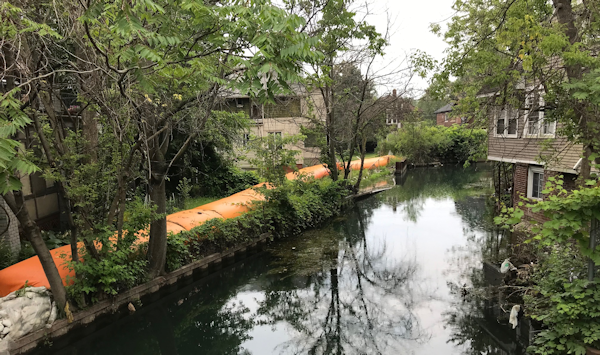SEJournal Online is the digital news magazine of the Society of Environmental Journalists. Learn more about SEJournal Online, including submission, subscription and advertising information.
 |
| Orange flood-control barriers run along a canal behind a row of homes on Detroit’s east side. The draining of wetlands in the city exacerbated recent flooding. Photo: Hannah Northey. |
Inside Story: Diving Deeper on the Wetlands Beat Yields Groundbreaking Coverage
A reporting duo’s ongoing coverage of the threats to America’s waterways and wetlands — and their connection to climate change and rising sea levels — won the pair an award for outstanding large-market beat coverage from the Society of Environmental Journalists’ 21st Annual Awards for Reporting on the Environment. Judges praised coverage from Hannah Northey and Kevin Bogardus of E&E News, calling it “a comprehensive and impactful portrait [that reflected] smart and groundbreaking reporting on a beat that often gets scant attention." The SEJournal Online recently caught up with Northey and Bogardus by email. Here is the conversation.
SEJournal: How did you get your winning story ideas?
Hannah Northey and Kevin Bogardus: Our series, “Unmitigated Damage: Inside the Federal Fight To Save Wetlands,” consists of five stories that stem from aggressive and comprehensive coverage of the water policy beat, from the use of the Freedom of Information Act and spreadsheets to on-the-ground reporting. One exclusive on how a Trump-era rule imperiled more than 40,000 waterways was based on federal data that showed the true reach of the Trump administration’s Clean Water Act rule, while a story on how wetland restoration is being eyed as a hedge against climate change gave a clear window into federal scientists’ ongoing work to preserve and restore coastal wetlands to fight sea level rise.
For another story, we used documents obtained from a successful appeal under FOIA to show how U.S. scientists at the Environmental Protection Agency said they were ignored when raising concerns about a pump project in the Yazoo Backwater area of Mississippi. A fourth story used FOIA to show that a top lawmaker, Democratic Rep. Bennie Thompson of Mississippi, called for an investigation of the EPA’s handling of the matter. Lastly, the package included on-the-ground reporting in a piece that explored how a majority-Black city in Michigan is grappling with the health and environmental effects of historic flooding.
SEJournal: What was the biggest challenge in reporting the pieces and how did you solve that challenge?
Northey and Bogardus: One of the biggest challenges we faced in reporting one of the stories in the package, on how the Trump EPA handled scientists’ warnings on the Mississippi project, was that we were initially denied a FOIA request for specific documents showing the EPA had ignored scientists concerned about the Yazoo pump project. We responded to that challenge by appealing the agency's decision to deny us those documents and won. The result allowed us to provide readers with an inside look at what happened around the EPA’s Yazoo pump project.
SEJournal: What most surprised you about your reporting?
Northey and Bogardus: After winning the appeal and obtaining internal EPA documents, we got an inside look at the concerns that federal scientists had voiced and then learned they were not addressed by the agency. That was a surprising and informative finding that then led us to search for other documents showing a top lawmaker had requested an investigation. Without the use of FOIA, these discoveries would not have been possible.
SEJournal: How did you decide to tell these stories and why?
‘Each piece is unique … but together they give a
larger view of what the federal government
is doing to advance the restoration and
protection of these rare places.’
— Hannah Northey and Kevin Bogardus
Northey and Bogardus: The five stories included in the package all reflect unique and effective ways of obtaining information and ultimately show how the federal government — from policy decisions to research and rulemaking — is fighting to save the nation’s wetlands and waterways in the face of climate change. We included them in the final package because each piece is unique in how the reporting was approached, but together they give a larger view of what the federal government is doing to advance the restoration and protection of these rare places.
SEJournal: Does the issue covered in your stories have disproportional impact on people of low income, or people with a particular ethnic or racial background? What efforts, if any, did you make to include perspectives of people who may feel that journalists have left them out of public conversation over the years?
Northey and Bogardus: Indeed, the degradation of wetlands and water pollution has an outsized effect on minority communities and this package includes on-the-ground reporting from the city of Detroit, which saw the draining of wetlands that exacerbated recent, historic flooding. Hannah traveled to the city and spoke with people living there about how they were impacted, learned about the history of drainage in the city and talked to officials about possible solutions. This was a thread carried throughout the package of stories.
SEJournal: What would you do differently now, if anything, in reporting or telling the series and why?
Northey and Bogardus: We would have traveled to the Yazoo region in Mississippi to speak directly to residents there about chronic flooding, to learn about the local ecosystems and rare wetlands, and to see where the pump station would have been built. Although we didn’t have time for that travel, those interviews would have provided a valuable window into life in the Delta region and insight into both the factors fueling flooding there and potential solutions.
SEJournal: What lessons have you learned from your stories?
Northey and Bogardus: We’ve learned to dig deeper and challenge agencies when they decline to provide information. By asserting our rights and pushing for the documents under FOIA, for example, we unearthed critical information about a federal project and scientific concerns that ultimately affected public policy.
SEJournal: What practical advice would you give to other reporters pursuing similar projects, including any specific techniques or tools you used and could tell us more about?
Northey and Bogardus: Reporters should think outside the box to obtain information needed for stories. This package reflects all the various ways reporters can do their job — FOIA, FOIA appeals, crunching data, on-the-ground reporting and interviews. Keep digging and get creative!
 |
Hannah Northey covers the nexus of water policy and politics for E&E News out of the Great Lakes state of Michigan. Her work on wetlands and climate change was also recognized by both the Washington, D.C., and Detroit chapters of the Society of Professional Journalists. Northey previously covered energy policy and Congress and served as E&E News' energy editor. Before that she worked for a host of Michigan outlets including The Ann Arbor News, Lansing State Journal and Michigan Public Radio. She has a master’s degree in environmental journalism from Michigan State University’s Knight Center.
 |
Kevin Bogardus covers the workforce and inner workings of the EPA and other federal agencies, including the departments of Energy and the Interior. He worked previously at The Hill, where he tracked lobbying, business and labor, and at the Center for Public Integrity. He has won several local and national journalism awards, including from the Society of Professional Journalists and the SEJ. He has a bachelor’s degree in English from the College of the Holy Cross.
* From the weekly news magazine SEJournal Online, Vol. 8, No. 10. Content from each new issue of SEJournal Online is available to the public via the SEJournal Online main page. Subscribe to the e-newsletter here. And see past issues of the SEJournal archived here.













 Advertisement
Advertisement 



